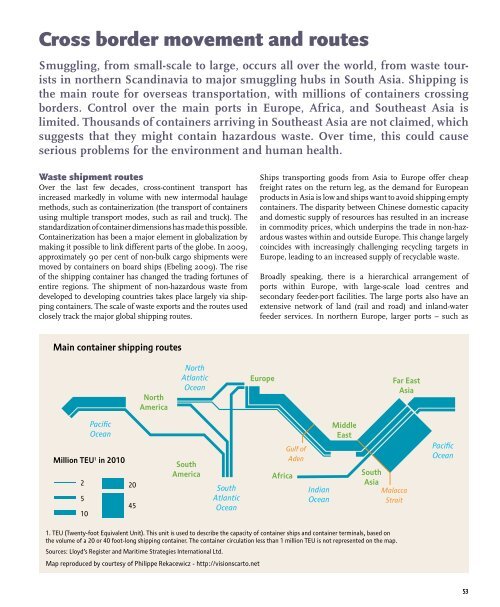WASTE CRIME – WASTE RISKS
6VhhXcA80
6VhhXcA80
Create successful ePaper yourself
Turn your PDF publications into a flip-book with our unique Google optimized e-Paper software.
Cross border movement and routes<br />
Smuggling, from small-scale to large, occurs all over the world, from waste tourists<br />
in northern Scandinavia to major smuggling hubs in South Asia. Shipping is<br />
the main route for overseas transportation, with millions of containers crossing<br />
borders. Control over the main ports in Europe, Africa, and Southeast Asia is<br />
limited. Thousands of containers arriving in Southeast Asia are not claimed, which<br />
suggests that they might contain hazardous waste. Over time, this could cause<br />
serious problems for the environment and human health.<br />
Waste shipment routes<br />
Over the last few decades, cross-continent transport has<br />
increased markedly in volume with new intermodal haulage<br />
methods, such as containerization (the transport of containers<br />
using multiple transport modes, such as rail and truck). The<br />
standardization of container dimensions has made this possible.<br />
Containerization has been a major element in globalization by<br />
making it possible to link different parts of the globe. In 2009,<br />
approximately 90 per cent of non-bulk cargo shipments were<br />
moved by containers on board ships (Ebeling 2009). The rise<br />
of the shipping container has changed the trading fortunes of<br />
entire regions. The shipment of non-hazardous waste from<br />
developed to developing countries takes place largely via shipping<br />
containers. The scale of waste exports and the routes used<br />
closely track the major global shipping routes.<br />
Ships transporting goods from Asia to Europe offer cheap<br />
freight rates on the return leg, as the demand for European<br />
products in Asia is low and ships want to avoid shipping empty<br />
containers. The disparity between Chinese domestic capacity<br />
and domestic supply of resources has resulted in an increase<br />
in commodity prices, which underpins the trade in non-hazardous<br />
wastes within and outside Europe. This change largely<br />
coincides with increasingly challenging recycling targets in<br />
Europe, leading to an increased supply of recyclable waste.<br />
Broadly speaking, there is a hierarchical arrangement of<br />
ports within Europe, with large-scale load centres and<br />
secondary feeder-port facilities. The large ports also have an<br />
extensive network of land (rail and road) and inland-water<br />
feeder services. In northern Europe, larger ports <strong>–</strong> such as<br />
Main container shipping routes<br />
Main container shipping routes<br />
North<br />
America North<br />
America<br />
North<br />
Atlantic North<br />
Atlantic Ocean<br />
Ocean<br />
Europe<br />
Europe<br />
Far East<br />
Far Asia East<br />
Asia<br />
Pacific<br />
Middle<br />
Pacific Ocean<br />
Middle East<br />
Ocean<br />
Gulf of East<br />
Million TEU 1 in 2010<br />
Aden<br />
South<br />
Gulf of<br />
Million TEU 1 in 2010<br />
America<br />
Aden<br />
Africa<br />
South<br />
South<br />
2<br />
20<br />
Asia<br />
America South Africa<br />
South<br />
Indian<br />
Malacca<br />
52<br />
20<br />
Atlantic<br />
Asia<br />
South<br />
Ocean<br />
Strait<br />
45<br />
Indian<br />
Malacca<br />
Ocean<br />
10 5<br />
Atlantic<br />
Ocean<br />
Strait<br />
45<br />
Ocean<br />
10<br />
1. TEU (Twenty-foot Equivalent Unit). This unit is used to describe the capacity of container ships and container terminals, based on<br />
the volume of a 20 or 40 foot-long shipping container. The container circulation less than 1 million TEU is not represented on the map.<br />
1. TEU (Twenty-foot Equivalent Unit). This unit is used to describe the capacity of container ships and container terminals, based on<br />
the Sources: volume Lloyd’s of a 20 Register or 40 foot-long and Maritime shipping Strategies container. International The container Ltd. circulation less than 1 million TEU is not represented on the map.<br />
Map Sources: reproduced Lloyd’s Register by courtesy and Maritime of Philippe Strategies Rekacewicz International - http://visionscarto.net<br />
Ltd.<br />
Map reproduced by courtesy of Philippe Rekacewicz - http://visionscarto.net<br />
Pacific<br />
Pacific Ocean<br />
Ocean<br />
53


